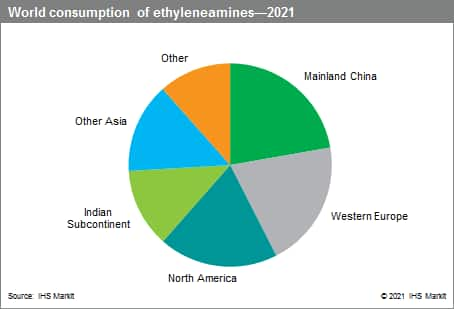Published December 2021
Ethyleneamines are chemicals that contain ethylene (-CH2CH2-) linkages between amine groups; these primary and/or secondary amino groups can react with many chemicals to produce a wide range of chemical products. Ethyleneamines are commercially produced via the monoethanolamine (MEA)/reductive amination (RA) process or the ethylene dichloride (EDC) process and are generally colorless, low-viscosity liquids with a fishy amine odor, although some are solids at room temperature. Although there have been some advancements in end-use markets in terms of chemistry and technology, the functionality requirements of ethyleneamine products have changed very little.
Asia, led by mainland China, accounted for nearly half of global consumption in 2021, followed by Western Europe and the United States. In terms of chemical type, ethylenediamine (EDA) accounted for nearly half of the total in 2021, followed by the higher amines, diethylenetriamine (DETA) and triethylenetetramine (TETA).
The following pie chart shows world consumption of ethyleneamines:

The largest application for ethyleneamines is in the production of chelating agents and polyamide/epoxy resins. EDA is consumed for nonreactive polyamides, while higher ethyleneamines are consumed for reactive polyamides. Ethyleneamines, primarily the higher amines (DETA, TETA, TEPA, and aminoethylpiperazine [AEP]), can be used directly as curing agents for epoxy resins. Chelating agents consume mainly EDA and DETA. Other major applications include lubricants, fungicides, polyamide-epichlorohydrin (PAE) wet-strength paper resins, and surfactants/fabric softeners.
The markets with the strongest growth prospects for ethyleneamines through 2026 are pharmaceuticals, polyamide/epoxy resins, and fungicides, all increasing at 4% or more per year. Overall ethyleneamines consumption is forecast to increase at 3.9% annually during 2021–26, with Asia, driven by India and mainland China, showing the strongest growth.
For more detailed information, see the table of contents, shown below.
S&P Global’s Chemical Economics Handbook – Ethyleneamines is the comprehensive and trusted guide for anyone seeking information on this industry. This latest report details global and regional information, including

Key Benefits
S&P Global’s Chemical Economics Handbook – Ethyleneamines has been compiled using primary interviews with key suppliers and organizations, and leading representatives from the industry in combination with S&P Global’s unparalleled access to upstream and downstream market intelligence and expert insights into industry dynamics, trade, and economics.
This report can help you
- Identify trends and driving forces influencing chemical markets
- Forecast and plan for future demand
- Understand the impact of competing materials
- Identify and evaluate potential customers and competitors
- Evaluate producers
- Track changing prices and trade movements
- Analyze the impact of feedstocks, regulations, and other factors on chemical profitability

















